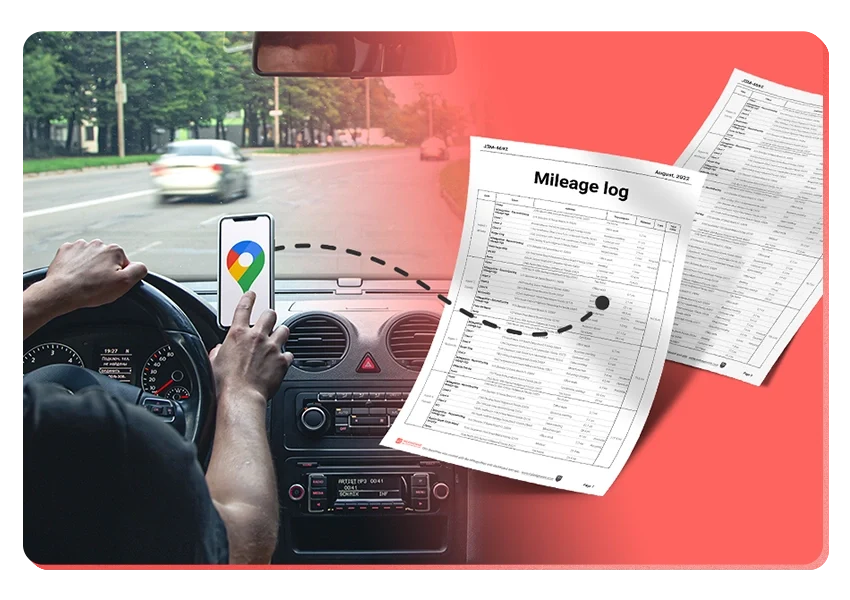Table of Contents
A driver’s daily log book is a must-have record for commercial drivers. It tracks your time driving, resting, and working. This helps you follow Hours of Service (HOS) rules set by the government. Using it right is key for road safety, following laws, and even solving work problems.
Understanding Your Driver’s Daily Log Book
Let’s break down what a driver’s daily log book is and why it’s so important. It’s more than just a notebook; it’s a legal record of your workday.
A driver’s daily log book tracks four main things:
- Driving time: When you’re actually controlling the vehicle.
- On-duty not driving: When you’re working but not driving, like inspecting the truck or waiting for loads.
- Resting: Time spent off-duty, relaxing, or in the sleeper berth.
- Off-duty: Your personal time away from work.
Keeping accurate records in your driver’s daily log book helps prevent drivers from becoming too tired. Tired drivers are a big safety risk on the road. The government, especially the U.S. Department of Transportation (DOT), makes these rules to keep everyone safe.
You must carry your last 8 days of logs with you while driving. You need to show these logs if asked by a law enforcement officer during an inspection.
What Goes Inside Your Driver’s Daily Log Book?
Filling out your mileage log book correctly each day is crucial. It needs specific information to be official.
Every entry in your driver’s daily log book must include essential details. Let’s list the must-have items:
- Date of the log entry
- Start time of your 24-hour day. This is based on the time zone of your home base.
- Total miles you drove that day.
- The name of your employer (carrier), their main office address, and their DOT number.
- Details about your vehicle. This could be the license number or a number given by your company.
- Names of any other drivers with you.
- Your signature to show you believe the log is correct.
- The city and state every time your work status changes (like when you start driving or go off duty).
- How many total hours you spent in each work status (driving, on-duty not driving, resting, off-duty).
- Numbers from shipping documents, the name of who shipped the goods, and what you are hauling.
- Notes for anything that needs explaining about your day.
Think of your driver’s daily log book as telling the story of your day behind the wheel. Missing pieces can cause problems.
FAQ
What is a driver’s daily log book?
A driver’s daily log book is a record where commercial drivers document their hours of service, miles driven, and vehicle inspections each day to comply with regulatory requirements. This document can be a detailed mileage log spreadsheet or just a notebook.
Why is maintaining a daily log book important?
Keeping an accurate log book ensures compliance with hours-of-service rules, helps prevent fatigue-related accidents, and provides documentation in case of roadside inspections or audits. Mileage trackers, such as the Hurdlr: Mileage, Expense & Tax app or the Stride app, help you keep a neat mileage log and help you with taxes.
How can MileageWise simplify daily log book management?
MileageWise automates trip capture and log creation, lets drivers review and edit your driving history easily, and creates your mileage logbook in minutes that meet regulatory standards, saving time and reducing errors. Furthermore, it can use your Google Maps Timeline data to create mileage logs even if you forgot to track your miles.
Try MileageWise for free for 14 days. No credit card required!
Related Terms

Our New Timeline Import App
Our new Timeline Import app makes it incredibly easy to turn your Google Maps Timeline trips into a clean, accurate, and IRS-proof mileage log. Without

DoorDash Tips and Tricks: Your Edge Over Competition
Last Updated: November 17, 2025 I’m excited to share the top DoorDash tips and tricks shared by YouTuber Pedro “Mr.BetonYou” Santiago. He collected and vetted the

8 Uber and Lyft Scams Every Driver Should Know
Last Updated: November 9, 2025 Driving for Uber or Lyft can be a rewarding gig, offering flexibility and the chance to meet new people. However,
SherpaShare Shutdown – What To Do Now?
Last Updated: October 7, 2025 SherpaShare was a service designed primarily for people who work as independent contractors, particularly those in the ride-sharing and delivery
Gas Mileage Tracker: Your Key to Savings
Last Updated: August 8, 2025 A gas mileage tracker helps drivers watch their vehicle’s fuel use, mileage, and related costs. You might want one to

How To Track Miles on iPhone: Find your Match
Last Updated: August 6, 2025 Looking to track miles on your iPhone? Whether it’s for fitness, personal use, or business tax deductions, your iPhone offers
Related Guides


It’s Finally Here! Google Maps Timeline Import from Mobiles
Transform your Trip Lists into Mileage Logs with MileageWise

Our New Timeline Import App
Our new Timeline Import app makes it incredibly easy to turn your Google Maps Timeline trips into a clean, accurate, and IRS-proof mileage log. Without

DoorDash Tips and Tricks: Your Edge Over Competition
Last Updated: November 17, 2025 I’m excited to share the top DoorDash tips and tricks shared by YouTuber Pedro “Mr.BetonYou” Santiago. He collected and vetted the

8 Uber and Lyft Scams Every Driver Should Know
Last Updated: November 9, 2025 Driving for Uber or Lyft can be a rewarding gig, offering flexibility and the chance to meet new people. However,
SherpaShare Shutdown – What To Do Now?
Last Updated: October 7, 2025 SherpaShare was a service designed primarily for people who work as independent contractors, particularly those in the ride-sharing and delivery
Gas Mileage Tracker: Your Key to Savings
Last Updated: August 8, 2025 A gas mileage tracker helps drivers watch their vehicle’s fuel use, mileage, and related costs. You might want one to

How To Track Miles on iPhone: Find your Match
Last Updated: August 6, 2025 Looking to track miles on your iPhone? Whether it’s for fitness, personal use, or business tax deductions, your iPhone offers

Was Your Google Timeline Deleted? Here’s What Happened:
Last updated: November 20, 2025 If you recently opened Google Maps and noticed your Timeline was deleted or partially missing, you’re not alone. In this

It’s Finally Here! Google Maps Timeline Import from Mobiles
Struggling to Manage Your Trips After Google’s Timeline Update? If you’re reading this, you’ve likely encountered the recent update affecting Google Maps Timeline. With Timeline
Transform your Trip Lists into Mileage Logs with MileageWise
Last Updated: October 1, 2025 Do you have a list of monthly trips from a data source like Excel or Google Timeline, but need to

How to Download Google Timeline Data: A Guide
Google Timeline Import Hub Last Updated: October 30, 2025 Want to download Google Timeline data? This guide shows you how to extract your location history

How to Export Google Maps Timeline: Get Your Data
Google Timeline Import Hub Last Updated: October 29, 2025 It can be tricky to export Google Maps Timeline data after Google’s recent updates. Many users
Google Maps Mileage Tracker: From Timeline to Mileage Log
Google Timeline Import Hub Last Updated: October 29, 2025 If you’re an active user of Google Maps Timeline you likely already know how convenient it
Timeero
Table of Contents Timeero Timeero is a time, location, and mileage tracking app designed for businesses and teams in the United States. It helps employers
Milewise by Allstate
Table of Contents Milewise by Allstate Milewise by Allstate is a pay-per-mile car insurance program offered by Allstate Insurance in the United States. It’s designed
Hurldr
Table of Contents Hurdlr Hurdlr is a finance and expense tracking app designed for self-employed professionals, freelancers, and gig workers in the United States. It








